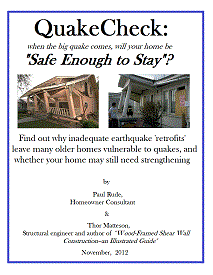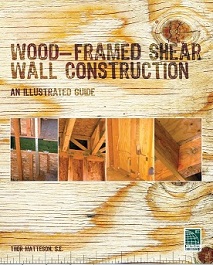
Want to see more detailed information on
earthquake retrofitting methods?
Check out this Indiegogo site to
sponsor a book on earthquake retrofitting
Or see Chapter 6 of the book below:
Order the Shear Wall Guide from the International Code Council
Further Information on Earthquake Safety
(FEMA documents, other references)
Can you use the Association of Bay Area Governments' Standard Plan A (commonly called "Plan Set A") to strengthen your house?
Plan Set A includes eight "yes or no" questions that are meant to help you determine whether you can use it to strengthen your home to better resist earthquakes. If you cannot use Plan Set A, you may be required to hire an engineer to design your earthquake retrofit.Depending on your local building department, you may still be able to use Plan Set A to install "Voluntary Strengthening" measures. If you are not trying to get a tax rebate (offered by some cities) or a reduction in your earthquake insurance premiums, most building departments will let you make your house stronger without getting an engineer's help in designing the retrofit work. (You may need to prove that you are not creating some other problem that would make the house perform worse in an earthquake--it is possible to strengthen part of the house, but make the overall structure worse off.) Also, if regulations are enacted in the future that require earthquake retrofitting, a non-engineered retrofit installation that did not follow Plan Set A may need to be re-done to meet the new regulations.
If you can afford it, a retrofit design by an engineer with experience designing residential retrofits is the best way to go. For simple homes that meet the criteria given in Plan Set A, there may be little difference between a specifically engineered design and work done under Plan Set A. After all, a team of engineers, contractors, building inspectors, and other experts worked very hard to create Plan Set A so it would meet earthquake strengthening standards for as many house configurations as possible.
Explanations for the eight requirements from Plan Set A
If you answer "no" to any of the following eight questions, then Plan Set A does not apply to your house. Getting the questions to fit a "yes-or-no" format made some of them very confusing; comments to help clarify the intent of the questions are given in italic type
- Is your home a one or two family residential structure?
This may not be an entirely simple question. In the case of "tenants-in-common" (TIC) arrangements, what was once a single-family home is now owned by multiple families. Logic could say that if the house was originally built as a single-family home, then Plan Set A would apply. If there are three or more owners in a TIC, best to inquire of your building department. (TICs are unusual outside of San Francisco, where most houses do not qualify for Plan Set A anyway because of the limit on cripple wall height.) - Is your home two stories or less?
The earthquake forces in three-story and taller houses are too great to use a 'standard' strengthening approach. It is not clear whether split-level houses qualify to use the plan set. Other "standard" plans (in Los Angeles or Seattle) also state that the floors at a particular story must be at the same level, which disqualifies split-level homes from using the standard plan. - Is your home wood-framed construction?
If your house is brick, stone, concrete, terra cotta tile, or some other construction you will need a retrofit design from an engineer. Since the vast majority of houses on the west coast are wood-framed, this requirement does not disqualify many of them. You can almost always tell if your house is wood-framed by looking in the crawl space; if you see wood stud cripple-walls around the perimeter (similar to the photos shown in QuakeCheck), you almost always have wood framing. - Does the building have a continuous perimeter concrete foundation (ignoring the immediate area surrounding the fireplace? porches?)
There are two main points here: 1) It is acceptable for an otherwise continuous perimeter foundation to be interrupted by a fireplace; and 2) the perimeter foundation must support all of the exterior walls of the house. In some houses the foundation follows the outline of the front porch (see Figure 4.3 in QuakeCheck), in which case Plan Set A does not apply. - Does your house have a crawlspace?
All of the work shown in Plan Set A takes place in the crawl space. - Are the cripple-walls less than 4 feet in height?
This restriction limits Plan Set A more than any other. Cripple walls braced with plywood tend to rock up and down due to back-and-forth earthquake loads acting along the tops of the walls. This tendency increases as the wall height increases. Four feet was chosen to match the height limit used in the International Existing Building Code; for walls over 4 feet tall, you are expected to get an engineered design.
The odd thing is that the building codes that govern NEW construction allow plywood-braced cripple walls up to 10 feet tall without engineering, as long as they are at least four feet wide and only support one story. (In less seismically-active areas, two stories are allowed above; but the single-story limit applies almost everywhere in California.) This inconsistency makes it harder to retrofit existing homes than to rebuild them after they get knocked down by an earthquake.
One reason given for limiting wall height to 4 feet in retrofits is that the code for new construction also relies on certain foundation properties (and other factors), whereas a retrofit gets built on older, shallow foundations. But there is not enough difference to justify this entirely. - If your home has brick or stone veneer along the exterior walls (excluding any chimneys), is the maximum height of the veneer 4 feet above the foundation?
If your house has brick or stone veneer on the outside, the veneer cannot be taller than four feet above the foundation. Earthquake forces are related to the weight of your house. Brick veneer adds a lot of weight, and increases the earthquake forces substantially. Plan Set A does not provide for adequate strength to resist the increased earthquake forces. - If the roofing of your home is clay tile, are the tiles installed without the use of mortar along the tile edges?
This item also relates to the weight of your house. One of the heaviest roof materials is Spanish tile (also called "barrel tile" or "Mission tile"). This sort of tile was typically installed with mortar along the edges of the roof. Houses with Spanish tile roofs often have very thick stucco exteriors, which also increases the weight. This style of house was deemed too heavy to safely use the requirements given in Plan Set A, which apply to more typical residential construction. Clay tile WITHOUT mortar is usually not so heavy, so is acceptable in Plan Set A.
